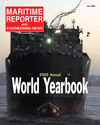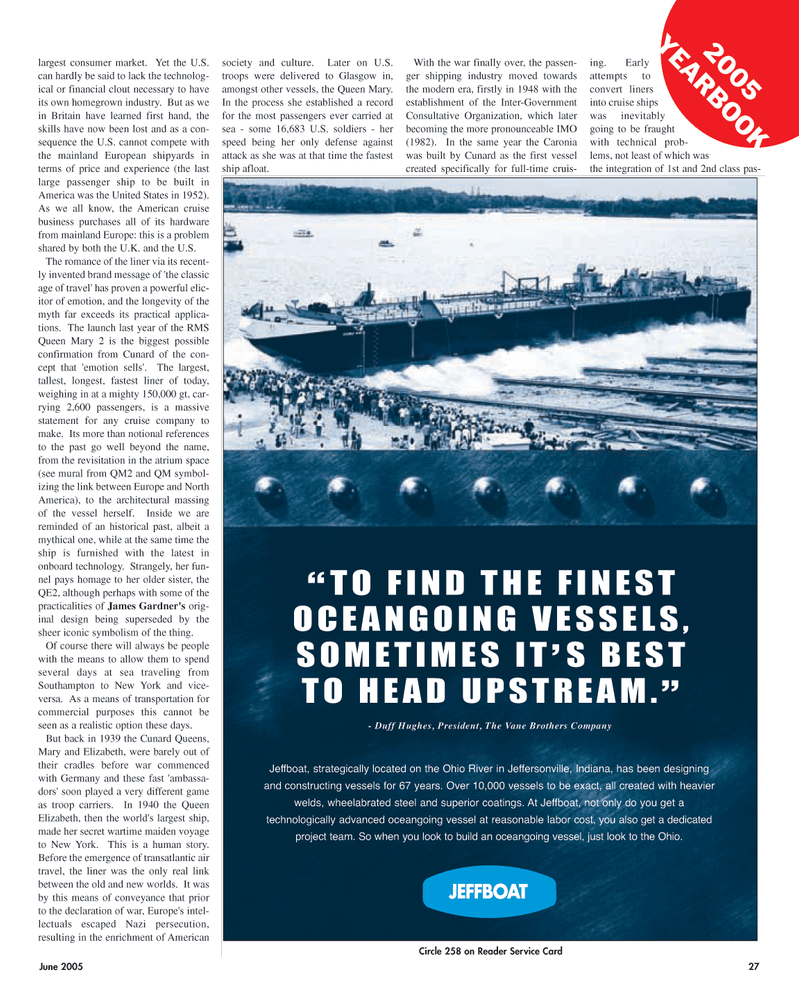
Page 27: of Maritime Reporter Magazine (June 2005)
Annual World Yearbook
Read this page in Pdf, Flash or Html5 edition of June 2005 Maritime Reporter Magazine
largest consumer market. Yet the U.S. can hardly be said to lack the technolog- ical or financial clout necessary to have its own homegrown industry. But as we in Britain have learned first hand, the skills have now been lost and as a con- sequence the U.S. cannot compete with the mainland European shipyards in terms of price and experience (the last large passenger ship to be built in
America was the United States in 1952).
As we all know, the American cruise business purchases all of its hardware from mainland Europe: this is a problem shared by both the U.K. and the U.S.
The romance of the liner via its recent- ly invented brand message of 'the classic age of travel' has proven a powerful elic- itor of emotion, and the longevity of the myth far exceeds its practical applica- tions. The launch last year of the RMS
Queen Mary 2 is the biggest possible confirmation from Cunard of the con- cept that 'emotion sells'. The largest, tallest, longest, fastest liner of today, weighing in at a mighty 150,000 gt, car- rying 2,600 passengers, is a massive statement for any cruise company to make. Its more than notional references to the past go well beyond the name, from the revisitation in the atrium space (see mural from QM2 and QM symbol- izing the link between Europe and North
America), to the architectural massing of the vessel herself. Inside we are reminded of an historical past, albeit a mythical one, while at the same time the ship is furnished with the latest in onboard technology. Strangely, her fun- nel pays homage to her older sister, the
QE2, although perhaps with some of the practicalities of James Gardner's orig- inal design being superseded by the sheer iconic symbolism of the thing.
Of course there will always be people with the means to allow them to spend several days at sea traveling from
Southampton to New York and vice- versa. As a means of transportation for commercial purposes this cannot be seen as a realistic option these days.
But back in 1939 the Cunard Queens,
Mary and Elizabeth, were barely out of their cradles before war commenced with Germany and these fast 'ambassa- dors' soon played a very different game as troop carriers. In 1940 the Queen
Elizabeth, then the world's largest ship, made her secret wartime maiden voyage to New York. This is a human story.
Before the emergence of transatlantic air travel, the liner was the only real link between the old and new worlds. It was by this means of conveyance that prior to the declaration of war, Europe's intel- lectuals escaped Nazi persecution, resulting in the enrichment of American society and culture. Later on U.S. troops were delivered to Glasgow in, amongst other vessels, the Queen Mary.
In the process she established a record for the most passengers ever carried at sea - some 16,683 U.S. soldiers - her speed being her only defense against attack as she was at that time the fastest ship afloat.
With the war finally over, the passen- ger shipping industry moved towards the modern era, firstly in 1948 with the establishment of the Inter-Government
Consultative Organization, which later becoming the more pronounceable IMO (1982). In the same year the Caronia was built by Cunard as the first vessel created specifically for full-time cruis- ing. Early attempts to convert liners into cruise ships was inevitably going to be fraught with technical prob- lems, not least of which was the integration of 1st and 2nd class pas- “ TO FIND THE FINEST
OCEANGOING VESSELS,
SOMETIMES IT’ S BEST
TO HEAD UPSTREAM.” - Duff Hughes, President, The Vane Brothers Company
Jeffboat, strategically located on the Ohio River in Jeffersonville, Indiana, has been designing and constructing vessels for 67 years. Over 10,000 vessels to be exact, all created with heavier welds, wheelabrated steel and superior coatings. At Jeffboat, not only do you get a technologically advanced oceangoing vessel at reasonable labor cost, you also get a dedicated project team. So when you look to build an oceangoing vessel, just look to the Ohio.
Circle 258 on Reader Service Card 2005
YEARBOOK
June 2005 27
MR JUNE 2005 #4 (25-32).qxd 6/2/2005 7:05 PM Page 27

 26
26

 28
28
